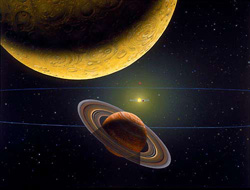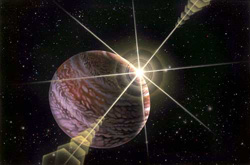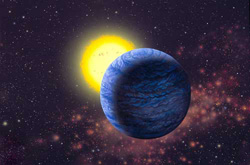Our own solar
system of nine planets is not alone in space. Over the last five years
astronomers have discovered 31 other planetary systems around other
suns and this number is rising fast. These discoveries have given
us our first opportunity to compare our system with others, and what
has been found has defied all expectations…..
by Kevin
Apps
October 6th
1995 is not a day etched firmly in the minds of many but perhaps
it should be. It was on this day that a Swiss team of astronomers
announced to the world the first definitive detection of a planet
orbiting another sun.
People had wondered
about the existence of extra-solar planets for centuries. But finding
them was to be no easy task. Unlike the stars, planets do not generate
any visible light of their own but merely "shine" by reflecting
their own sun's light. Imagine looking at our sun from the nearest
star, a distance of about 40 trillion kilometres. The distance between
the Sun and Jupiter would be appear equivalent to the distance between
a car's headlamps, 50 kilometres away! Combine this with the problem
that the visible light from Jupiter is 250 million times fainter
than that from the Sun. Trying to find extra-solar planets is like
trying to see a firefly sitting on a searchlight from many kilometres
away! This is why extra-solar planets have not been seen directly
- they are known to exist because of the gravitational effects they
have on their parent suns.
How do you
find an extra-solar planet?
The first technique
tried was Astrometry. This involved precise measurement of the stars'
positions in the sky and looking for the telltale 'wobbles' in their
orbits caused by the gravitational tug of an orbiting planet.

Lynette
Cook
Detecting
the 'wobble' these planets cause in their sun's motion requires
very precise measurements.
|
For the last
50 years astronomers have looked for these wobbles and despite a
handful of false claims have not found any. The blurring effects
of the earth’s unsteady atmosphere makes accurate measurement
of so small a motion difficult.
There is however
another way to look for these 'wobbles'. Instead of measuring motion
in the plane of the sky you can measure the motion along the line
of sight. This is known as the Radial Velocity method and is how
all the extra-solar planets have been found to date.
It works by
utilising the Doppler effect. This effect can be heard on sirens.
When a police car is moving towards you the pitch of its siren sounds
slightly higher, and then lower as the car passes you and moves
away. The same effect happens with light waves. When a star is approaching
the Earth the light it emits appears to shift towards shorter wavelengths,
and equivalently to longer ones if it is moving away. This can be
measured by splitting the starlight into its constituent wavelengths
and measuring these shifts. The effects are tiny, for example the
effect of Jupiter's pull on our sun would appear as a change in
the wavelengths of Sunlight of less than 1 part in 10 million when
viewed from a distant star.
This is extremely
difficult to measure and requires both the finest equipment and
also a lot of ingenuity and patience. Many measurements of a star’s
velocity need to be taken over time to see the periodic motion caused
by an orbiting planet. From these measurements you can calculate
the orbital period of the planet and the eccentricity (which indicates
if the orbit is circular or elliptical) and estimate further properties
of the planet such as its orbital distance and mass.
Expectations
Planets are
thought to form as a product of star formation. Newly born stars
are usually surrounded by a rotating disk of material several times
the size of our own solar system. This disk, called a protoplanetary
disk is mainly composed of gas but also contains a mixture of both
dust and ice grains. These grains are thought to grow, over hundreds
of thousands of years, by process known as collisional accretion
into planetary mass bodies. Close to the star where temperatures
are too high for ice to exist, rocky planets like the earth are
expected to form. Further out ice is far more abundant so huge icy
protoplanets can quickly grow and then gravitationally capture the
surrounding gas from the disk before it dissipates away. It is by
this process that giant planets like our own Jupiter and Saturn
are thought to have formed.
This is what
we expected to find. Like in our own solar system, small rocky planets
close in to the star and more massive giant planets like Jupiter
and Saturn orbiting beyond 4 or 5 AU (one AU is the distance between
the earth and the sun). We also expected roughly circular orbits.
All of the four giant planets in our own solar system as well as
Venus and Earth have orbits that are close to circular. Indeed the
theories of planetary formation tend to have planets forming on
circular orbits due the damping influences of the protoplanetary
disk.

Lynette
Cook
Only
the giant planets of ice and gas can be detected
|
A
surprise or two in store!
Unfortunately
with the current radial velocity technique only the most massive
planets like Jupiter and Saturn are detectable. Small earth-like
planets do not have the gravitational muscle to be detectable. In
our solar system our two giant planets orbit at about 5 and 10 AU
in near circular orbits and they take about 12 and 29 years to do
so respectively. The various radial velocity surveys have only been
recording precision data for about 5 to 6 years. Hence they are
only sensitive to planets with orbital periods shorter than this
(a complete orbit of a planet needs to be observed before its existence
is confirmed). Therefore all the planets announced so far have orbital
periods shorter than 5 years and are much closer to their star than
Jupiter is to the Sun.
The startling
diversity
Time and time
again in the history of science, nature has turned out to be more
diverse and fascinating than scientists had predicted - the realm
of extra solar planets is certainly no exception. The most unexpected
find has been the location of these giant planets in their systems.
We have found a range of orbital distances, from 0.05 AU which is
eight times closer in than our closest planet Mercury, right out
to the current detection limit of about 2 - 3 AU which is similar
to the distance of the asteroid belt in our system, just beyond
Mars. Indeed some of these gargantuan gas balls are located at a
distance where liquid water, the necessary ingredient for life could
well exist on the surface of any moons they might posses.
Recall that
it is thought that gas giant planets form out where ices are abundant
in the protoplanetary disk (at distances of about 4 AU or greater).
That they are seen much closer in suggests they might migrate inwards
over the lifetime of the protoplanetary disk (thought to be in the
range of 1 to 10 million years). This migration could be caused
by gravitational torque interactions with the viscous protoplanetary
disk. This is one possible explanation for the wide range of orbital
distances we see. There also appears to be a pile up of planets
in very small ~0.05 AU orbits. This may be due to the young star
clearing a hole in the inner disk, perhaps by the influence of it’s
strong magnetic field, so that the inwardly migrating planet halts
when it reaches this hole and is stopped from spiralling into the
star. Another idea is that the planet may be halted by tidal effects
at small orbital radii.

Lynette
Cook
Virtually
all the extrasolar planets discovered have more eccentric
orbits than our own giant planets.
|
The other big
surprise has been the generally non-circular orbits of the newly
found planets. Those planets in very small (~0.05 AU) orbits are
expected to have circular orbits because the gravitational influence
of their parent star should tidally circulise the orbit and cause
the rotation period of the planet to match its orbital period. This
latter effect is seen in our Earth/Moon system in the way that the
Moon always keeps the same face pointed towards the Earth. Amongst
the more distantly orbiting planets (those where this process doesn’t
occur) the majority of orbits are quite eccentric. Indeed virtually
all are more eccentric than the orbits of all the giant planets
in our own solar system.
Since planets
are expected to form in circular orbits this may indicate building
solar systems is a chaotic process. Perhaps several giant planets
are formed which then gravitationally interact with each other.
Simulations of this process show that planets can often be either
ejected from their solar system in this way, or have their orbits
altered in size and shape, with wildly eccentric orbits being a
common outcome. Whatever the case, it seems that our stable solar
system of widely spaced circularly orbiting planets may be an unusual
outcome.
The most massive
planets found are somewhere around 8-10 times Jupiter’s mass.
However the number of planets increases towards lower masses, right
down to the current detection limits of around 0.5 times Jupiter’s
mass. This trend may well carry on beyond this current threshold
- the planets that have been found might be just the tip of the
iceberg. Even extrapolating from the ones found so far indicates
at least 2 to 3% of sun like stars have giant planets; there must
be over a billion planets in our galaxy alone!
The parent stars
themselves are also of interest. Most planets have been found around
G type stars (like our Sun) but this could be partly due to the
fact that more of these stars are being targeted. Only one red dwarf
star has been found to have a planet though, despite many being
searched. This may indicate that these faint low mass stars which
are the most common in the galaxy may not be as commonly attended
by large planets as the more massive Sun-like stars. The planet
bearing stars also tend to be richer than average in metallic elements
as well as carbon, nitrogen and oxygen (which are the elements from
which the planet-forming grains in the protoplanetary disk are composed
of).
The
icing on the cake
Two systems
deserve special mention. The first is the multiple planetary system
around the star Upsilon Andromedae. This system is composed of three
giant planets. The first one is in a circular orbit very close to
its parent star, the second in an eccentric orbit at a distance
similar to Venus in our solar system and the most massive one also
in an eccentric orbit somewhat further out than Mars. Several other
systems are showing evidence of additional planets, which may indicate
that given the right conditions multiple giant planets are often
formed in the same system.

Lynette
Cook
We
can see the shadow this planet casts on its sun.
|
The planet around
the star HD209458 is also an interesting case. It also orbits very
close to its sun and fortuitously its orbit is aligned almost edge
on to our line of sight. We know this because the planet has been
seen to pass in front of its sun, causing the star to dim slightly.
From precise measurement’s it has been determined that the
planet is 60% the mass of Jupiter but has a diameter 50% greater.
The planet orbits so close to its parent star that its temperature
is over 1000oC, its outer atmosphere swells up, causing
this bloating effect. These measurements also confirm it is made
primarily of gas like our own Jupiter and Saturn.
The future
As more planets
will be found over the coming years from these surveys we will be
able to understand the distribution of planetary masses, eccentricities
and orbital distances in these alien systems better. We will learn
more about multiple planetary systems and the relations between
the properties of the parent stars and the types of planets they
host. Within 5 to 10 years we will know about the rate of occurrence
of planetary systems that have giant planets that resemble our own
Jupiter, i.e. in more distant circular orbits. These types of systems
may have habitable planets like our own.
However, to
find Earth sized planets we will need to place arrays of telescopes
in space above the distorting effects of our atmosphere. This is
being planned, both Europe and the US are aiming to launch a mission
around 2010 that will not only look for Earth-like planets but also
search for evidence of life on them by looking for the signature
of ozone in the feeble glow they emit. Only then will we know if
our solar system is a unique or unusual example, or whether billions
of solar systems like ours exist in the vast depths of space.
|
